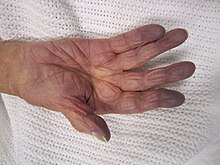| Hypoxia | |
|---|---|
| Other names | Hypoxiation, lack of oxygen, low blood oxygen (technically hypoxemia), oxygen starvation |
 | |
| Cyanosis of the hand in an elderly person with low oxygen saturation | |
| Specialty | Pulmonology, toxicology |
| Symptoms | Cyanosis, numbness or pins and needles feeling of the extremities |
| Complications | Gangrene, necrosis |
| Risk factors | Diabetes, coronary artery disease, heart attack, stroke, embolism, thrombosis, deep-vein thrombosis, tobacco smoking |
Hypoxia is a condition in which the body or a region of the body is deprived of adequate oxygen supply at the tissue level.[1] Hypoxia may be classified as either generalized, affecting the whole body, or local, affecting a region of the body.[2] Although hypoxia is often a pathological condition, variations in arterial oxygen concentrations can be part of the normal physiology, for example, during strenuous physical exercise.
Hypoxia differs from hypoxemia and anoxemia, in that hypoxia refers to a state in which oxygen present in a tissue or the whole body is insufficient, whereas hypoxemia and anoxemia refer specifically to states that have low or no oxygen in the blood.[3] Hypoxia in which there is complete absence of oxygen supply is referred to as anoxia.
Hypoxia can be due to external causes, when the breathing gas is hypoxic, or internal causes, such as reduced effectiveness of gas transfer in the lungs, reduced capacity of the blood to carry oxygen, compromised general or local perfusion, or inability of the affected tissues to extract oxygen from, or metabolically process, an adequate supply of oxygen from an adequately oxygenated blood supply.
Generalized hypoxia occurs in healthy people when they ascend to high altitude, where it causes altitude sickness leading to potentially fatal complications: high altitude pulmonary edema (HAPE) and high altitude cerebral edema (HACE).[4] Hypoxia also occurs in healthy individuals when breathing inappropriate mixtures of gases with a low oxygen content, e.g., while diving underwater, especially when using malfunctioning closed-circuit rebreather systems that control the amount of oxygen in the supplied air. Mild, non-damaging intermittent hypoxia is used intentionally during altitude training to develop an athletic performance adaptation at both the systemic and cellular level.[5]
Hypoxia is a common complication of preterm birth in newborn infants. Because the lungs develop late in pregnancy, premature infants frequently possess underdeveloped lungs. To improve blood oxygenation, infants at risk of hypoxia may be placed inside incubators that provide warmth, humidity, and supplemental oxygen. More serious cases are treated with continuous positive airway pressure (CPAP).
- ^ Cite error: The named reference
Samuel and Franklin 2008was invoked but never defined (see the help page). - ^ Cite error: The named reference
Das et al 2019was invoked but never defined (see the help page). - ^ Cite error: The named reference
West 1977was invoked but never defined (see the help page). - ^ Cite error: The named reference
Cymerman and Rockwas invoked but never defined (see the help page). - ^ Cite error: The named reference
Gore et al 2007was invoked but never defined (see the help page).